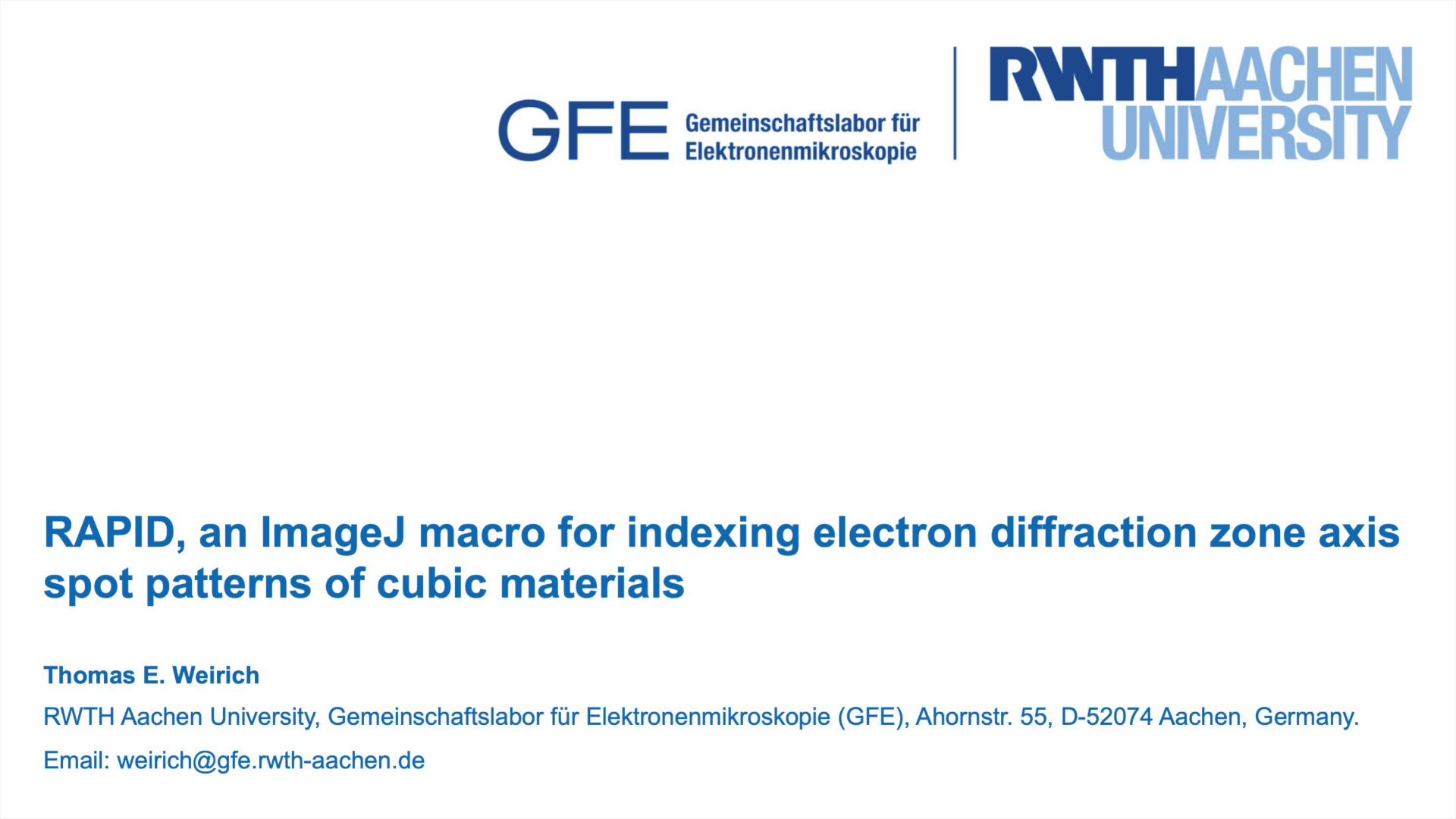ElCryst
Accelerate TEM Data Analysis with
Electron Crystallography Tools
RAPID-IJ
RAPID (RAtio method Pattern InDexing) is an ImageJ macro script developed for the quick determination
of sample orientation and indexing of calibrated and uncalibrated zone axis aligned electron diffraction
patterns from materials with a cubic crystal structure. In addition to conventional SAED patterns,
the program is also capable of handling zone axis TEM Kikuchi patterns and FFTs derived from HR(S)TEM images.
The software enables users to rapidly determine whether materials are cubic, pseudo-cubic, or non-cubic,
and to distinguish between P, I, F and diamond lattices. It can also provide lattice parameters for material
verification and aid in determining the camera constant of the instrument, thus making the program a convenient
tool for on-site crystallographic analysis in the TEM laboratory.
A quick intro on how to use RAPID for ImageJ.
Tutorial: Indexing an SAED pattern from austenitic steel X5CrNiMo with RAPID for ImageJ.
Tutorial: Indexing an SAED pattern of M23C6 precipitates in austenitic steel with RAPID for ImageJ.
Tutorial: Indexing a Kikuchi pattern in alloy AlZn5Mg with RAPID for ImageJ (1st version).
Tutorial: Indexing the FFT of a HRTEM image from a magnetite nanocrystal with RAPID for ImageJ.
See more and download RAPID from Zenodo
RAPID-DM
A DigitalMicrograph® script RAPID-DM (RAtio method Pattern InDexing) has been developed, which allows instant on-site
indexing of zone axis electron diffraction patterns of cubic lattices using the Rn ratio principle. In addition to indexing
spot electron diffraction patterns, the program is also capable of indexing Kikuchi patterns taken from or near a zone axis.
Both cases are demonstrated by examples for silicon. The program has a guided workflow and requires only three user-defined
lines or Kikuchi bands for indexing. RAPID-DM has been extensively tested and verified to work reliably with both calibrated
and noncalibrated zone axis patterns and allows the user to easily evaluate whether the material under examination is cubic,
pseudo-cubic, or neither. For calibrated patterns, the program provides an average value of the cubic lattice parameter, which
can serve for phase identification in connection with a structural database or it can simply be used to verify the material
under investigation.
Watch the above video to see how RAPID-DM can be used to index
an SAED pattern of a twin crystal in austenitic steel.
Read more and download RAPID-DM from Zenodo
RAPID-JS (outlook)
RAPID-JS, is a browser-based implementation of the Rn-ratio method for indexing selected area electron diffraction patterns of cubic and pseudocubic materials. Implemented in Svelte/ECMAScript (JavaScript)
and accelerated by precomputed lookup tables, RAPID-JS allows the interactive indexing of calibrated and uncalibrated selected area electron diffraction
spot patterns via a graphical user interface. The program supports standard image formats for pattern import, and returns lattice orientations and diffraction spot indices within user-defined tolerances for ratios and angles.
RAPID-JS is a lightweight, cross-platform tool designed to facilitate the quick on-site analysis of selected area electron diffraction patterns in electron microscopy and crystallography research and teaching courses.
RAPID-JS, our youngest member in the RAPID family. Cross-platform. No installation. No internet.
Just Javascript in your web-browser.
FINDS
FINDS is an ImageJ macro script that assists in the evaluation of selected area electron diffraction (SAED) patterns
that contain numerous diffraction spots arranged on concentric but incomplete rings. The program allows the user to mark
diffraction spots of known phases by overlaying rings on the pattern, making it easy to identify and address additional
(unidentified) reflections between them. In addition to the full functionality for calculating and plotting the diffraction
ring patterns of known phases in different styles and colours, FINDS also provides tools for locating spot positions and
determining the corresponding d-values of the reflections of interest.
Download FINDS from Zenodo
RIPAS
RIPAS (RIng PAttern Simulation) is a user-friendly native cross-platform desktop
application designed for simulating electron powder diffractograms of both amorphous and crystalline
materials. For the calculation of the diffraction patterns, the program only requires the interplanar
spacings (d values) of the material and, if available, the corresponding reflection intensities. The
patterns generated by the program can be superimposed on experimental diffraction patterns for ease of
analysis and documentation.
Download the full article from RWTH publications
CELLFINDER
CELLFINDER is an ImageJ script that determines the 2D unit cell from the peaks in HAADF STEM images by using angle-resolved
lattice population density (ALPD) plots. As the maxima in ALPD plots represent the lines with the highest atom peak density,
the cell angle of the primitive 2D unit cell can be readily identified, and a 2D unit cell can be constructed. Furthermore,
the introduction of angle constraints for the selection of ALPD maxima allows the identification of 2D unit cell sizes that
comply with crystallographic standards.
Read the full article at SYMMETRY
UNITCELL SAED
UNITCELL SAED has been developed for the ImageJ/Fiji platform to obtain precise 2D unit cell parameters from selected area electron
diffraction (SAED) patterns aligned along a zone axis. In addition to error analysis based on comparison of observed and calculated
d-spacings, the program allows the verification of different 2D symmetries and supports the re-indexing of 2D HK indices to 3D hkl
indices for subsequent use with other crystallographic software.
Download the full article from RWTH publications






